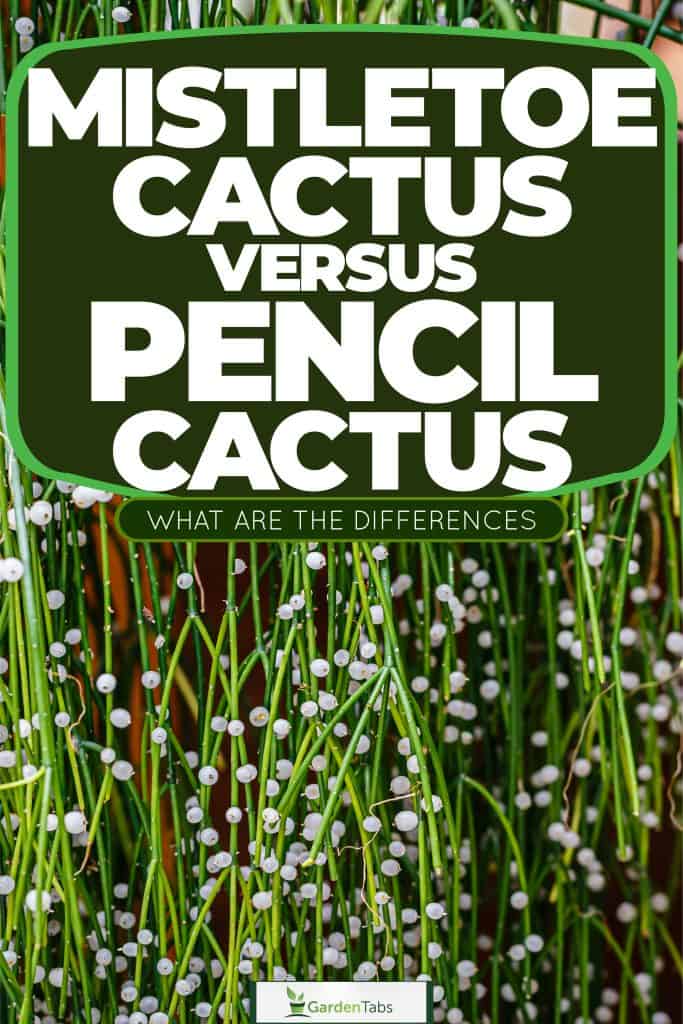Being able to identify a plant correctly is essential in gardening. With this knowledge, you can give your plants the environment they need to thrive. The mistletoe cactus and pencil cactus look incredibly similar. So, how do you tell them apart? We've done the research and can tell you how these plants differ.
The mistletoe cactus (Rhipsalis baccifera) is a cactus that can grow up to 30 feet long in ideal conditions. It has hanging tendrils, which makes them suitable for hanging pots.
You should put mistletoe cactus where it receives bright but indirect sunlight. These plants also aren't drought tolerant.
The pencil cactus (Euphorbia tirucalli) is a cactus-like, single, or multi-stemmed shrub or tree that typically reaches heights of 30 feet outdoors and 6 feet indoors. The sap is toxic and corrosive.
Pencil cacti thrive in full sun and can tolerate periods of drought. These plants can be grown indoors or out but are intolerant to frost.
As you can see, knowing the difference between these two plants is critical for keeping you and your family safe. Keep reading to learn more about these plants, their differences, and more!
Differences Between Mistletoe and Pencil Cacti
While they look similar, mistletoe cactus and pencil cactus are actually very different. One significant distinction is that the pencil cactus is not a true cactus. It is actually a part of the Euphorbiaceae family. Plants in this family are known as succulents. However, they are not cacti and only look like them.
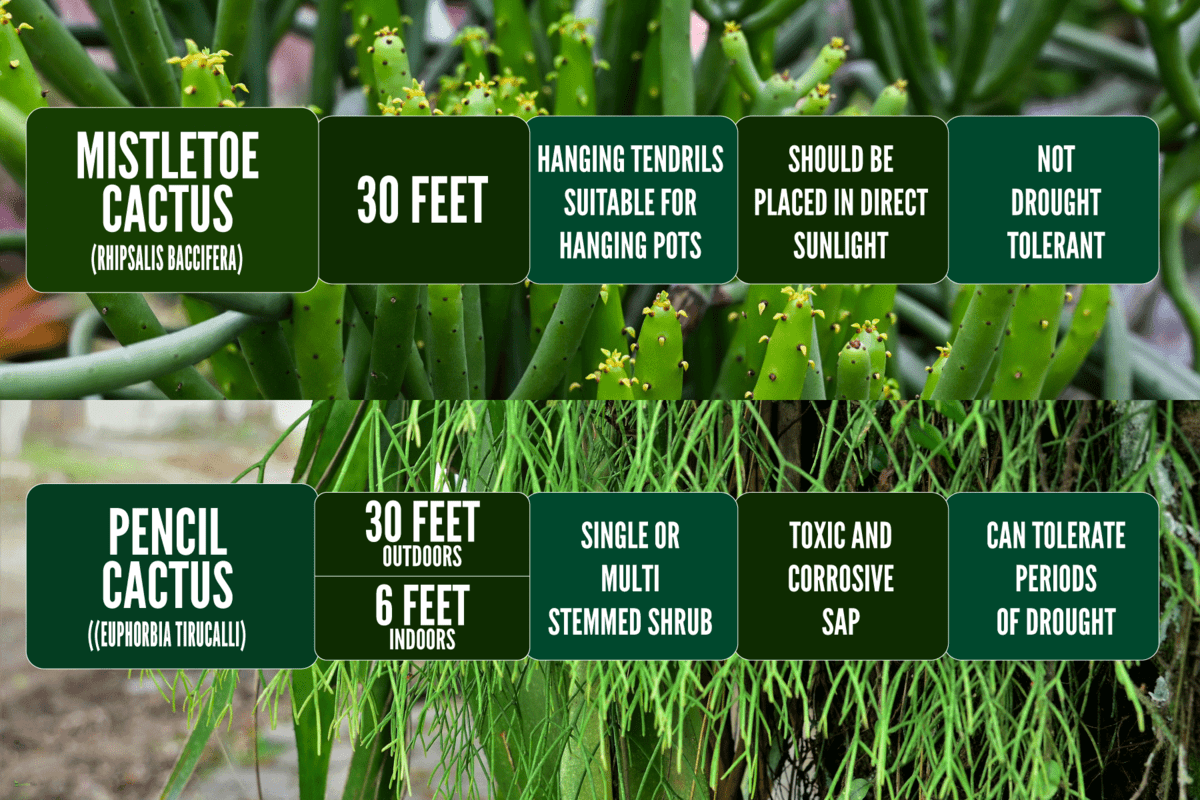
In comparison, the mistletoe cactus is a part of the family Cactaceae, which are considered true cacti. These plants are unique when compared to others in the same family.
Mistletoe cacti are epiphytic, which means that they grow on other plants. While mistletoe cacti do gain support from the plant, they aren't considered parasitic and shouldn't cause harm to the host plant.
Size
The pencil cactus can be grown as an indoor or outdoor plant. When grown outdoors, these plants can reach up to 30 feet tall and spread up to 10 feet.
If grown as a houseplant, the pencil cactus will have a mature height of six feet tall and a three-foot width. Under the right conditions, this plant can grow up to 20 inches in one year.
In comparison, the mistletoe cactus can have tendrils that are six feet long and spread two feet wide. In their natural habitats, these plants can grow as long as 30 feet with a 5-foot spread.
Keep in mind that mistletoe cacti are very slow growers. So, it can take several years to have a long, trailing plant. They will grow slightly faster if grown in ideal conditions.
Toxicity
Pencil cacti are hydrocarbon plants. They produce milky-white sap or latex that can be used as fuel. However, this substance is irritating to the skin. Any contact can cause severe irritation, redness, and burning.
There are also health problems if you ingest the pencil cactus. There can be burning on the lips, mouth, tongue, and mucous membranes.
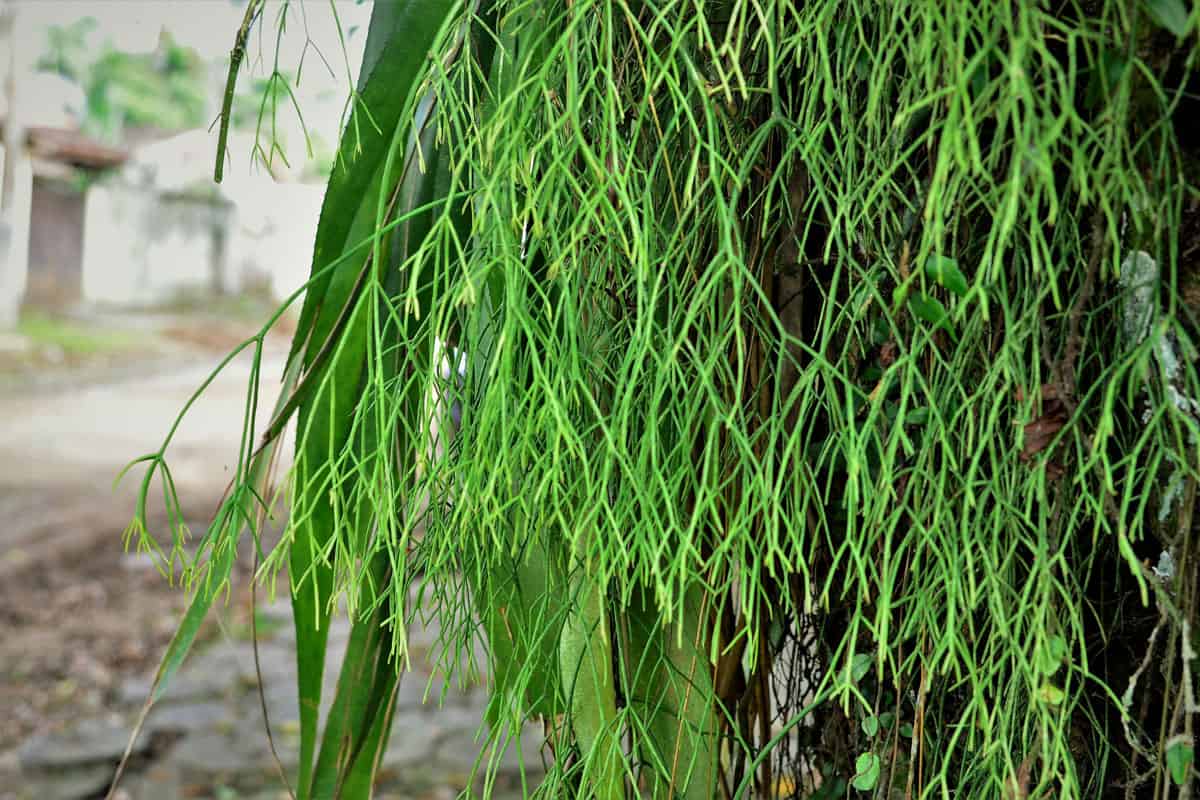
Pencil cacti cause the same problems in animals. It can cause vomiting in dogs, cats, and horses. Contact your local veterinarian if you suspect your pet has ingested some of this plant.
In comparison, mistletoe cactus is non-toxic to pets and humans. The small white or yellow fruits have a light, sweet taste. In the wild, birds will feed on the berries and distribute the seeds. If grown as a houseplant, you can also feel free to eat the fruit.
Growing Conditions
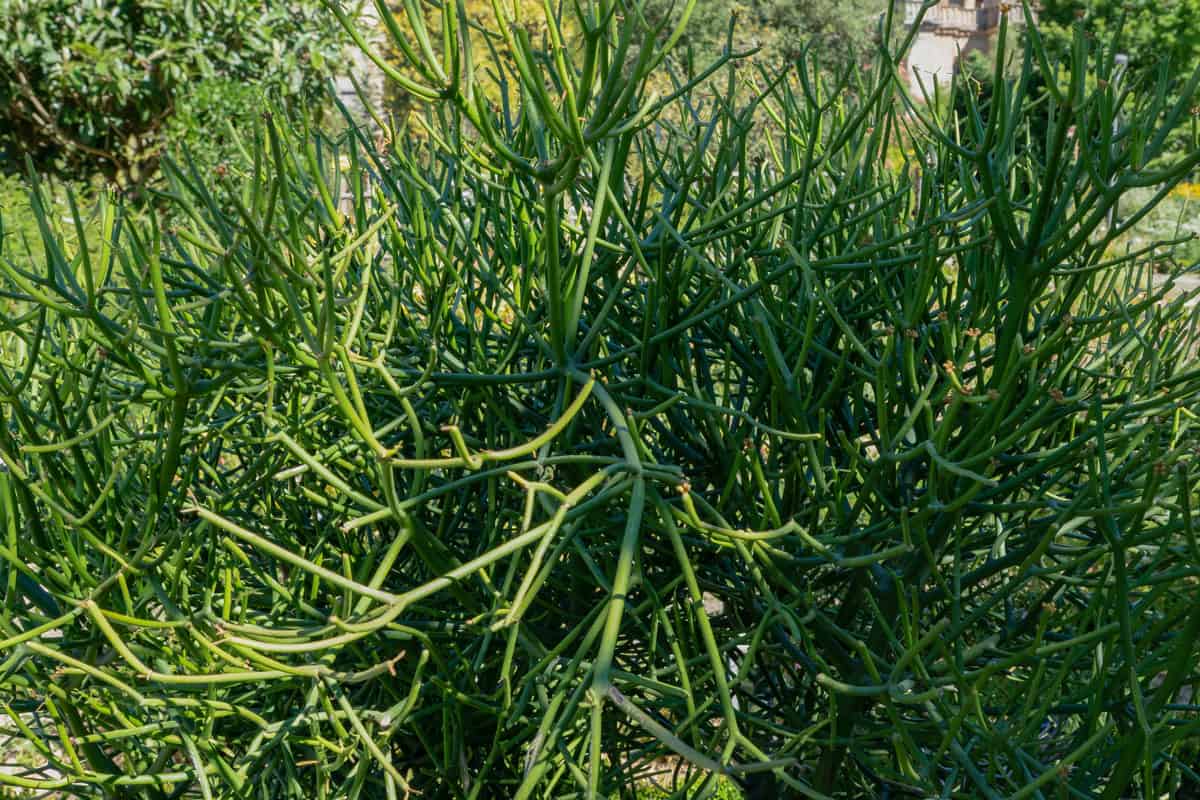
Pencil cacti are hardy for USDA Zones 9 through 12. If planting outdoors, you should aim to give this plant at least six hours of sunlight. However, protecting the plant from the afternoon sun may be beneficial.
These plants will do best when the daytime temperatures are around 75 degrees Fahrenheit and evening temperatures remain over 50 degrees Fahrenheit.
They prefer areas with low humidity and dry, sandy, well-drained soil. You should wait to water your plant until the top few inches of soil have dried out. You can increase or decrease your watering depending on the time of year.
If you live in a colder zone, you should keep your pencil cactus as an indoor plant. In these cases, you should keep them close to your brightest window and away from any cold drafts.
When growing in containers, you should use well-draining loamy soil. You can mix in gritty material, like sand, to help with drainage.
Check out this live plant on Amazon!
Mistletoe Cactus Growing Conditions

The mistletoe cactus is hardy for USDA zones 9 through 11. It is commonly found growing on trees, so it's more used to indirect sunlight throughout the day. When selecting a location, be mindful that an indoor location can receive both direct and indirect sunlight throughout the day.
Mistletoe cacti also prefer consistently moist, slightly acidic soil. However, it doesn't like water-logged soil.
Be sure to allow the first two inches of soil to dry before watering. If you start noticing wilting or mushy stems, you've been over-watering.
You also need to use lukewarm water. If you use cold water for this plant, it can ironize the roots and cause stunted growth.
These plants do well when the temperatures average between 60 and 80 degrees Fahrenheit, which is within the range of most normal households.
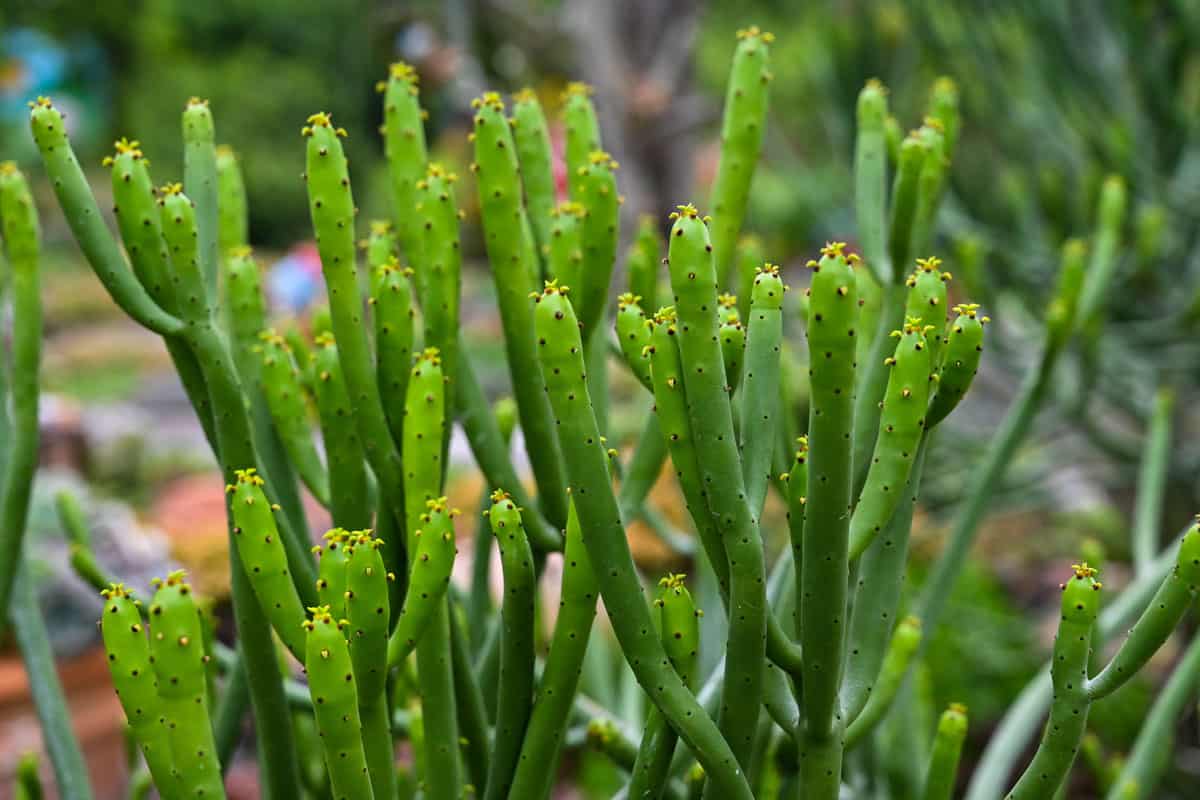
However, mistletoe cacti prefer high humidity. You may have low humidity if you notice browning tips on your plant. Move the plant away from any air vents or drafts.
If that's not the problem, then you should try placing a dish filled with water nearby or putting a humidifier nearby.
Looking for more moisture-loving plants? Check out "14 Bathroom Plants That Absorb Moisture And Reduce Humidity!"
Check out this live plant on Amazon!
Pruning
You should prune your pencil cactus in the spring after it starts actively growing.
You need to take extra precautions when pruning the pencil cactus. First, protect your eyes and skin from this plant's sap. You should also avoid composting your cuttings.
The first things you should remove are diseased, damaged, or dead branches. Next, prune to control shape and size. Avoid removing more than a third of the plant at once. Over-pruning can negatively affect its growth.
Once you're done, you should clean the shears you used to do the pruning. They will be sticky, and you also want to avoid contaminating another plant.
In comparison, mistletoe cacti need very little pruning. For this plant, you only need to prune when you see broken or diseased stems.
If you'd like to make your mistletoe cactus smaller, you can also prune it to control its shape. However, since this plant grows so slowly, you shouldn't have to do that very often.
To avoid spreading disease to your mistletoe cactus, you'll need to clean your shears before pruning. You can do this by wiping rubbing alcohol on them. Just be sure to clean the blade before starting the plant.
Check out "Where Do You Cut When Pruning A Plant? [And At What Angle?]" for more pruning tips.
Fertilizer
Since pencil cacti do so well in nutrient-light, sandy soil, you won't have to fertilize this plant often. If you decide to fertilize, only do it once a year during the springtime.
Applying too much fertilizer often can actually root burn, killing your plant.
Mistletoe cactus, on the other hand, will do well with light feedings throughout the growing season. Dilute liquid fertilizer and apply it once a month from spring until summer. You don't have to apply fertilizer in the fall and winter.
Check out this fertilizer on Amazon!
Pest and Disease Problems
Both of these plants are considered easy to care for. However, pencil cacti tend to have a bigger problem with pests. These plants are mildly susceptible to spider mites, aphids, and mealybugs.
Mistletoe cacti may face several disease problems if it's not being watered properly. Root rot is a very common issue. Yellowing leaves or missing leaves near the base is a sign that there is too much moisture on the foliage.
Your plant can also get sun scorched if placed in an area with high amounts of bright, direct sunlight.
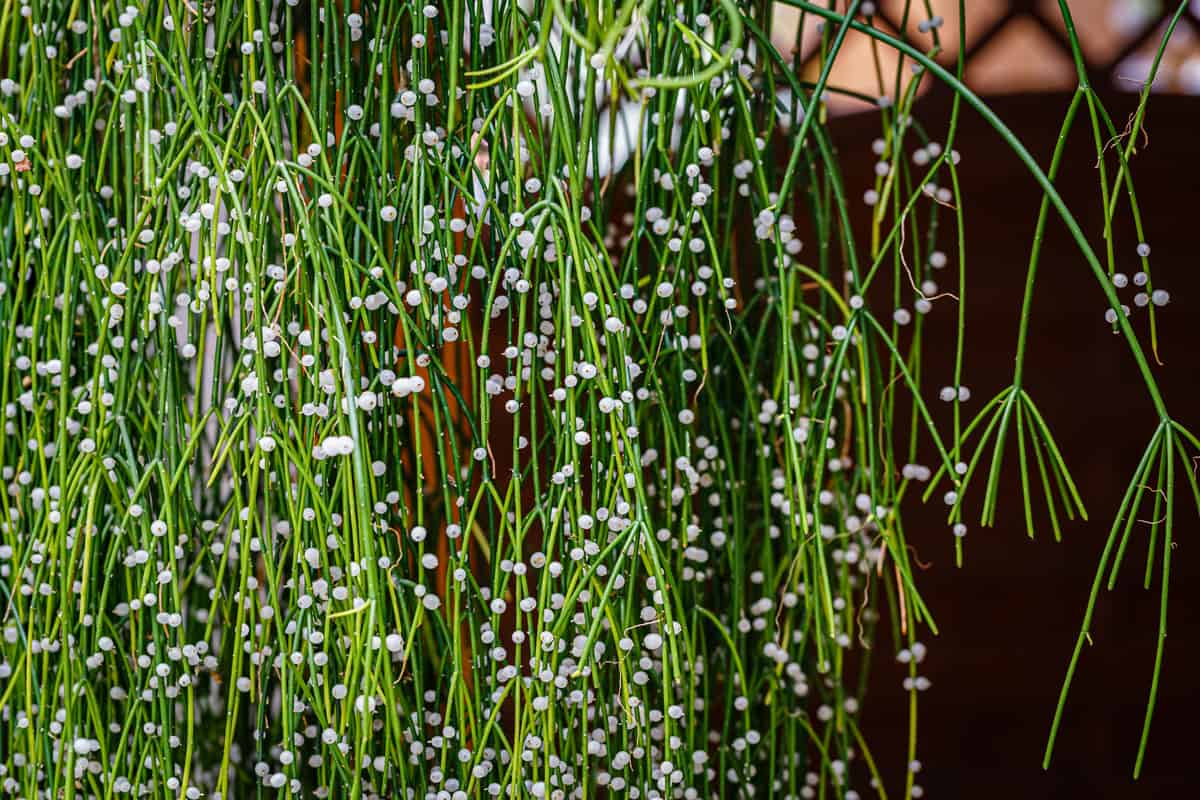
In Conclusion
Despite their similar appearances, mistletoe cacti and pencil cacti are very different. Knowing their differences can help you take great care of your plant and avoid accidental injuries from toxic sap.
If you enjoyed this article, be sure to read these great posts:
Orchid Cactus Vs. Dragon Fruit: What are the Differences?
How Large Do Christmas Cactus Grow?
Is this helpful? Use the Pinterest-ready image below to add this to your boards.
